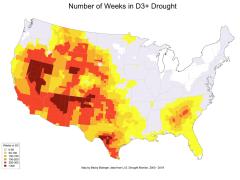For the latest forecasts and critical weather information, visit weather.gov.
Forecast-Informed Reservoir Operations (FIRO): Overcoming Barriers and Realizing Benefits
The University of Texas-Arlington, Texas Water Development Board, and NIDIS hosted an interactive workshop on September 12-13 in Arlington, Texas, to learn how NOAA forecasts have been applied in decision-support tools for water management in different states and discuss what steps are needed to integrate NOAA forecasts in reservoir operations and water resources management in the Southern Great Plains (Texas and Oklahoma). The workshop provided an opportunity for dialog between reservoir operators, water suppliers, state water agencies, and producers of seasonal and sub-seasonal forecasts and forecast products.
Slides from the workshop can be viewed here.

Workshop Objectives
- Learn from entities in other parts of the nation that have implemented, or are in the process of implementing FIRO
- Identify current and emerging NOAA operational products that can be readily used in the context of FIRO
- Understand the concerns that water operators have with using seasonal and sub-seasonal climate forecasts
What is FIRO?
Forecast-informed reservoir operations (FIRO) is a reservoir-operations strategy that uses enhanced monitoring and improved weather and water forecasts to inform decision making to selectively retain or release water from reservoirs to optimize water supply reliability and environmental co-benefits and to enhance flood-risk reduction.
For an overview of FIRO, see the Center for Western Weather and Water Extremes Website
Benefits of FIRO
FIRO provides an effective means of increasing the efficiency and resiliency of existing water resources infrastructure – all without costly construction projects (Cary Talbot, US Army Corps of Engineers)
FIRO Can Help Mitigate Drought Events
- The events at Lake Mendocino from 2012-2104 became the trigger for FIRO there. Atmospheric Rivers (ARs) led to high reservoir levels and the standard process of releasing water was achieved. But what followed next was a drought that dropped reservoir levels to historic lows. Using forecasts to predict the drought could have prevented the extreme drop in water supplies. (Marty Ralph, University of California – San Diego/Scripps Institution of Oceanography)
- Forecasts allow Brazos River Authority (Texas) to manage water supply by incorporating rainfall runoff and hydropower releases to help BRA determine the timing for initiating or discontinuing water supply releases. The Palmer Hydrological Drought Index has been incorporated into drought contingency as an early warning trigger and in the state approved water management plan/water accounting plan to determine hydrologic conditions. (Aaron Abel, Brazos River Authority)
FIRO Can Help Mitigate Extreme Flood Events
- Tennessee Valley Authority averted over $1.6 billion in flood damages in February 2019 through forecasting. For TVA, better forecasts equal lives and money saved. (Tom Zimmerman, Tennessee Valley Authority)
- The City of Houston will be implementing FIRO in response to Hurricane Harvey and other recent flood events, with the goal of pre-releasing water from Lake Houston if predicted rainfall is 3 inches or greater in the Lake Houston watershed within a 48 hour forecasted period. If this prediction occurs, Lake Houston will be lowered by 1 foot. (Drew Molly, City of Houston)
Barriers to FIRO
Workshop attendees discussed the need to improve the accuracy of sub-seasonal to seasonal (S2S) forecasting, both temporally and spatially. Accurately forecasting precipitation is more challenging than forecasting temperature, outside of a few weeks. So making FIRO work is an applied problem. We know a lot about the theory.
The following additional barriers or challenges were presented in applying FIRO:
- Lack of awareness and easy access to forecasts and models
- Prescriptive operations – can’t or won’t defer from the previous plan
- People intimidated to use the available forecasts and models
- Lack of available system models
- Limited tools for real time management
- Ability to store or process data
- Demonstrating value to management
- Social and environmental pressures
- Politics
- Need for local advocates and support
- Personal interests
- Optimality
- Preferences required when tradeoffs are present
--Jonathan Quebbeman, RTI International
Future Outlooks
A number of forecasting improvements were discussed at the workshop to help water suppliers, and the forecasting community in general, more accurately predict precipitation. One option is ensemble forecasting, including Hydrologic Ensemble Forecasting System (HEFS). HEFS is a National Weather Service probabilistic forecasting tool currently operational at 1246 locations throughout the US, which provides hydrologic forecasts including an analysis of “probable outcomes” and minimizes biases in the atmospheric models and in the hydrologic models. NOAA is also working on improving S2S forecasting, as are others. Below are a few of the techniques discussed at the workshop to improve FIRO.
Ideally FIRO would be based on a reliable skillful subseasonal to seasonal forecast used by water suppliers to hold water or release water if needed. But there are challenges in making reliable forecasts beyond two weeks with sufficient skill to inform reservoir management. An alternative option is experimental 6 to 10 day outlooks of extreme precipitation, with testing done by NOAA in the proximity of river basins in northern California. This technique showed promise in providing skillful information on the risk of 50 mm rainfall events and the reliability for predictions of low probability of such events. Nevertheless, the reliability decreased for precipitation forecasts of larger rainfall events. Ongoing efforts include experimental forecasts as guidance to inform deviations in reservoir flood-control and water supply operation rules, and partnerships to transfer experimental forecast information into easy-to-understand and usable products for reservoir flood-control/water supply operators. (Robin Webb, NOAA)
Atmospheric Rivers (ARs) are the key to water supply and flooding in the west as 84% of western US flood damages are associated with ARs and over 95% in key parts of California. ARs are also present in the Midwest as a recent one led to flooding in Nashville. If we can better anticipate ARs in the future, we’ll get closer to seasonal or sub-seasonal predictability. (Marty Ralph, University of California – San Diego/Scripps Institution of Oceanography)
The New York City Department of Environmental Protection (NYC DEP) uses HEFS in their routine operations and determined that ensemble forecasting is a paradigm shift. The Delaware River Basin in 2015 is among past important cases, as there was concern over drought during this time period. DEP used ensemble forecasts that consistently predicted that precipitation and snowmelt would be sufficient to avoid drought, and no further actions were needed regarding reservoir operations. The forecasts turned out to be accurate. In March 2016 there was no drought but by October 2016 drought had developed. This time the ensemble had a large spread including serious drought concerns. NYC DEP worked with its Delaware basin partners to approve a special permit allowing drought operations prior to crossing the drought watch line. These forecast-based, proactive reservoir operations likely helped to mitigate drought impacts and shorten the duration of time in drought status relative to letting the reservoir system enter drought and reacting after the fact (James Porter, NYC DEP (retired]).
The Southern Great Plains is a region of persistent drought interrupted by extreme rainfall events and flooding. Based on the presentations and lively discussions during the workshop, initial indications suggest that the application of the FIRO approach in the Southern Great Plains region represents an opportunity to augment water supply reliability in reservoir systems built and operated to manage flood control as well as an opportunity to augment flood protection in water supply reservoir systems built and operated to mitigate drought impacts.
Next Steps
A full Workshop Report will be produced this fall and will include all the highlights, key takeaways, and action items.





